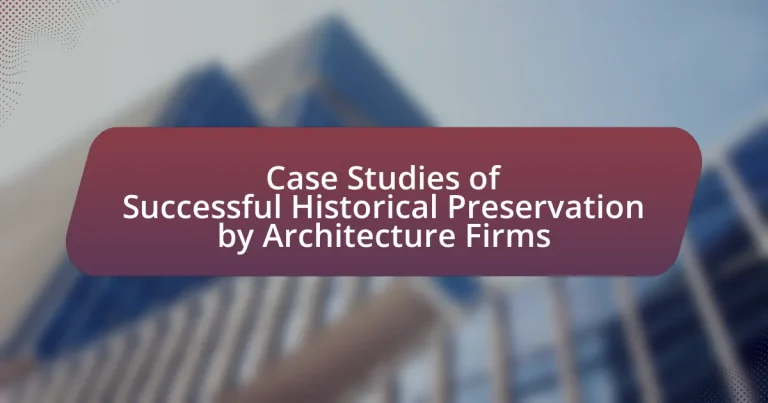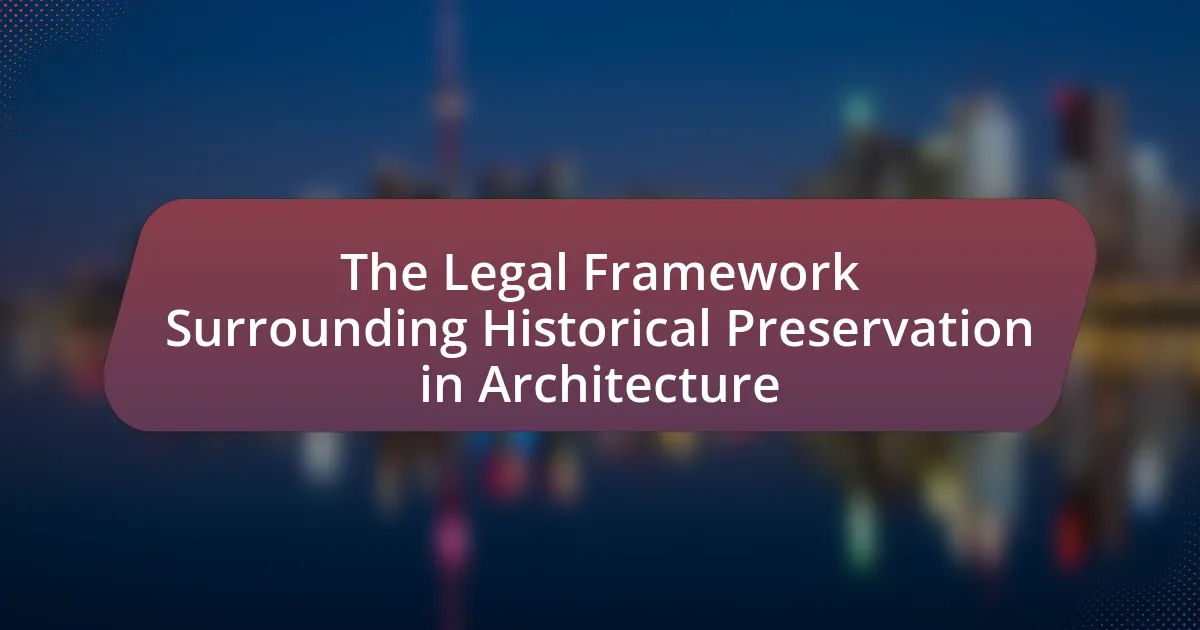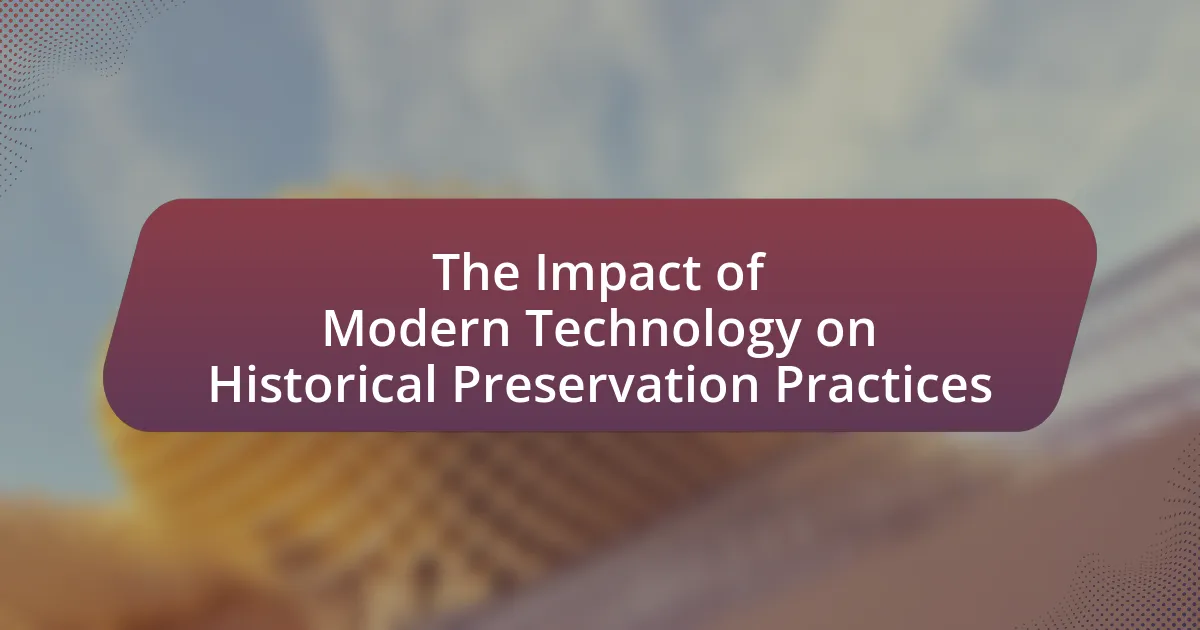The article focuses on case studies of successful historical preservation undertaken by architecture firms, highlighting notable projects such as the restoration of the Sydney Opera House, the rehabilitation of Union Station in Washington, D.C., and the transformation of the Tate Modern in London. It discusses the methodologies architecture firms employ to assess historical significance, balance modern needs with historical integrity, and ensure sustainability in preservation efforts. Key factors contributing to successful preservation include community engagement, adequate funding, and adherence to preservation standards. The article also outlines best practices for firms, challenges faced in maintaining historical integrity, and the role of technology and innovation in enhancing preservation outcomes.

What are Case Studies of Successful Historical Preservation by Architecture Firms?
Case studies of successful historical preservation by architecture firms include the restoration of the Sydney Opera House by architect Jørn Utzon, which involved meticulous attention to the original design while updating facilities for modern use. Another example is the rehabilitation of the historic Union Station in Washington, D.C., by the architecture firm Amtrak, which preserved the building’s Beaux-Arts style while enhancing its functionality as a transportation hub. Additionally, the renovation of the Tate Modern in London by Herzog & de Meuron transformed a former power station into a world-renowned art museum, maintaining the industrial character while providing contemporary exhibition spaces. These projects demonstrate how architecture firms can effectively balance preservation with modern needs, ensuring the longevity and relevance of historical structures.
How do architecture firms approach historical preservation in their projects?
Architecture firms approach historical preservation by integrating modern design principles with the original architectural elements of historic structures. They conduct thorough research to understand the historical significance and context of the building, often collaborating with historians and preservation specialists to ensure authenticity. For instance, firms may utilize techniques such as adaptive reuse, where they repurpose old buildings for new functions while maintaining their historical integrity. This method not only preserves the cultural heritage but also promotes sustainability by reducing the need for new construction. Evidence of successful historical preservation can be seen in projects like the restoration of the High Line in New York City, where the old elevated railway was transformed into a public park, preserving its historical features while serving a new purpose.
What methodologies do firms use for assessing historical significance?
Firms use a combination of qualitative and quantitative methodologies for assessing historical significance. These methodologies include archival research, which involves examining historical documents and records to understand the context and importance of a site, and field surveys that assess the physical characteristics and condition of historical structures. Additionally, firms often employ stakeholder consultations to gather insights from local communities and historians, ensuring that multiple perspectives are considered in the evaluation process.
For instance, the National Park Service in the United States utilizes the Historic Preservation Tax Incentives program, which requires a thorough assessment of a property’s historical significance based on established criteria, including age, integrity, and significance in American history. This structured approach provides a framework that firms can follow to ensure comprehensive evaluations.
How do firms balance modern needs with historical integrity?
Firms balance modern needs with historical integrity by integrating contemporary design elements while preserving the original architectural features. This approach often involves adaptive reuse, where existing structures are updated for modern functionality without compromising their historical significance. For instance, the renovation of the Tate Modern in London transformed a former power station into a contemporary art museum, maintaining its industrial character while accommodating modern art display requirements. Such projects demonstrate that thoughtful design can harmonize the old with the new, ensuring that historical narratives are respected while meeting current user needs.
What are the key factors that contribute to successful historical preservation?
The key factors that contribute to successful historical preservation include community engagement, adequate funding, and adherence to preservation standards. Community engagement ensures that local stakeholders are involved in the preservation process, fostering a sense of ownership and support. Adequate funding is crucial, as financial resources are necessary for restoration projects, maintenance, and ongoing preservation efforts. Adherence to preservation standards, such as those set by the National Park Service, guarantees that restoration efforts respect the historical integrity and authenticity of the site. These factors collectively enhance the likelihood of successful preservation outcomes, as evidenced by numerous case studies where community involvement and financial backing led to the effective restoration of historically significant sites.
How does community involvement impact preservation efforts?
Community involvement significantly enhances preservation efforts by fostering local support and ensuring that the historical significance of sites is recognized and valued. Engaged communities contribute valuable insights about their heritage, which can guide preservation strategies and promote sustainable practices. For instance, studies have shown that projects with strong community participation, such as the restoration of the historic district in Savannah, Georgia, lead to increased funding and volunteer efforts, resulting in more effective preservation outcomes. This collaborative approach not only strengthens the emotional connection residents have with their heritage but also encourages ongoing stewardship, as seen in various successful case studies across the United States.
What role does funding play in successful preservation projects?
Funding is crucial for the success of preservation projects as it provides the necessary financial resources to cover costs such as materials, labor, and expert consultations. Without adequate funding, projects may face delays, compromises in quality, or even cancellation. For instance, the restoration of the Notre-Dame Cathedral in Paris, which has an estimated cost of over €1 billion, highlights how significant financial backing is essential for comprehensive preservation efforts. Additionally, studies show that projects with secured funding are more likely to meet their timelines and maintain the integrity of historical elements, ensuring that cultural heritage is preserved effectively.
What are some notable case studies of successful historical preservation?
Notable case studies of successful historical preservation include the restoration of the Colosseum in Rome, Italy, and the rehabilitation of the High Line in New York City, USA. The Colosseum underwent extensive restoration starting in 1993, which involved structural stabilization and cleaning, preserving its integrity while enhancing its aesthetic appeal. This project was supported by the Italian government and private donations, showcasing a commitment to maintaining cultural heritage. The High Line, a former elevated railway, was transformed into a public park in 2009, preserving its industrial history while creating a vibrant urban space. This project was spearheaded by Friends of the High Line, demonstrating effective community involvement in historical preservation. Both case studies exemplify successful strategies in preserving historical sites while adapting them for contemporary use.
What lessons can be learned from the restoration of the Eiffel Tower?
The restoration of the Eiffel Tower teaches the importance of meticulous maintenance and the integration of modern technology with historical preservation. This project, completed in 1986, involved extensive repainting and structural reinforcement, demonstrating that regular upkeep is essential to prolonging the life of historical structures. The use of advanced materials and techniques, such as anti-corrosion treatments, highlights how contemporary innovations can enhance the durability of heritage sites. Furthermore, the restoration process emphasized the need for collaboration among architects, engineers, and conservationists, ensuring that the tower’s historical integrity was maintained while improving its safety and aesthetic appeal.
How did the preservation of the Getty Villa set a precedent for future projects?
The preservation of the Getty Villa established a precedent for future projects by demonstrating the effectiveness of integrating modern conservation techniques with historical authenticity. This project, completed in 2006, showcased how meticulous attention to detail in restoration can enhance the visitor experience while maintaining the integrity of the original architecture. The Getty Villa’s approach to using advanced materials and methods, such as the application of seismic retrofitting, has influenced subsequent preservation efforts by emphasizing the importance of safety alongside historical fidelity. This model has been referenced in various architectural guidelines and preservation standards, reinforcing its impact on future historical preservation initiatives.

How do architecture firms ensure the sustainability of historical preservation projects?
Architecture firms ensure the sustainability of historical preservation projects by integrating modern sustainable practices with traditional building techniques. They conduct thorough assessments of existing structures to identify materials that can be reused or restored, minimizing waste and preserving historical integrity. For example, firms often utilize energy-efficient systems, such as geothermal heating and solar panels, while maintaining the original aesthetics of the building. Additionally, they adhere to guidelines set by organizations like the National Trust for Historic Preservation, which emphasizes the importance of sustainable practices in preserving cultural heritage. This approach not only protects the environment but also enhances the longevity and usability of historical sites.
What strategies do firms implement to maintain historical sites over time?
Firms implement several strategies to maintain historical sites over time, including regular maintenance, adaptive reuse, and community engagement. Regular maintenance involves routine inspections and repairs to prevent deterioration, ensuring that structural integrity and historical features are preserved. Adaptive reuse allows firms to repurpose historical buildings for modern use while maintaining their historical significance, as seen in projects like the Tate Modern in London, which transformed a former power station into a contemporary art museum. Community engagement fosters local support and involvement, which is crucial for the sustainability of preservation efforts, as demonstrated by initiatives that involve local stakeholders in decision-making processes. These strategies collectively contribute to the long-term preservation of historical sites.
How do firms incorporate sustainable practices in preservation efforts?
Firms incorporate sustainable practices in preservation efforts by utilizing environmentally friendly materials, implementing energy-efficient technologies, and promoting adaptive reuse of existing structures. For instance, many architecture firms now prioritize the use of reclaimed wood and recycled materials in their projects, which reduces waste and minimizes the carbon footprint associated with new construction. Additionally, integrating energy-efficient systems, such as solar panels and high-performance insulation, helps to lower energy consumption in preserved buildings. A notable example is the renovation of the historic Ferry Building in San Francisco, where sustainable practices were employed to enhance its functionality while maintaining its historical integrity. This project not only preserved the building’s architectural significance but also achieved LEED certification, demonstrating the effectiveness of sustainable methods in historical preservation.
What are the challenges of maintaining historical integrity while ensuring sustainability?
Maintaining historical integrity while ensuring sustainability presents significant challenges, primarily due to the conflicting priorities of preserving original materials and design versus implementing modern, eco-friendly practices. Historical structures often require specific materials and techniques that may not align with contemporary sustainable building standards, leading to potential compromises in authenticity. For instance, using traditional lime mortar in restoration may not meet modern energy efficiency standards, which typically favor synthetic materials. Additionally, the financial implications of adhering to strict preservation guidelines can deter investment in sustainable upgrades, as seen in projects like the restoration of the historic Smithson Building in Washington, D.C., where balancing preservation with energy efficiency proved complex. These challenges necessitate innovative approaches that respect historical significance while integrating sustainable solutions, such as adaptive reuse strategies that honor original designs while enhancing energy performance.
How do technology and innovation play a role in historical preservation?
Technology and innovation significantly enhance historical preservation by enabling more accurate documentation, restoration, and conservation of heritage sites. Advanced tools such as 3D scanning and digital modeling allow architects and preservationists to create precise replicas of historical structures, facilitating restoration efforts while minimizing damage to original materials. For instance, the use of laser scanning technology has been employed in projects like the restoration of the Notre-Dame Cathedral, where detailed scans provided critical data for rebuilding efforts after the 2019 fire. Additionally, innovative materials and techniques, such as nanotechnology and environmentally friendly restoration compounds, improve the longevity and integrity of preserved sites. These advancements not only protect cultural heritage but also ensure that historical narratives are accurately conveyed to future generations.
What technologies are commonly used in the preservation process?
Common technologies used in the preservation process include 3D scanning, digital modeling, and advanced materials conservation techniques. 3D scanning allows for precise documentation of historical structures, capturing intricate details that can be used for restoration. Digital modeling enables architects to visualize and plan preservation efforts effectively, ensuring that historical integrity is maintained. Advanced materials conservation techniques, such as nanotechnology and bio-based materials, enhance the durability of original materials while minimizing environmental impact. These technologies collectively support the accurate and sustainable preservation of historical sites.
How can digital documentation aid in historical preservation efforts?
Digital documentation significantly aids in historical preservation efforts by providing accurate, high-resolution records of artifacts, structures, and sites. This technology allows for the creation of 3D models, detailed photographs, and comprehensive databases that capture the condition and context of historical items. For instance, the use of laser scanning and photogrammetry has been employed in projects like the preservation of the Notre-Dame Cathedral, where digital records were created before and after the fire, enabling restoration efforts to be based on precise historical data. Such documentation not only facilitates restoration but also enhances accessibility for research and education, ensuring that historical knowledge is preserved for future generations.

What best practices can architecture firms adopt for successful historical preservation?
Architecture firms can adopt several best practices for successful historical preservation, including thorough research, community engagement, and adherence to preservation standards. Conducting comprehensive historical research ensures that firms understand the significance and context of the structures they are preserving, which is crucial for maintaining authenticity. Engaging with the local community fosters support and gathers valuable insights, as community members often have historical knowledge and emotional ties to the buildings. Additionally, following established preservation standards, such as those set by the Secretary of the Interior, helps ensure that restoration efforts are respectful and appropriate, thereby enhancing the integrity of the historical site. These practices are validated by successful case studies, such as the restoration of the historic Boston City Hall, which involved extensive community input and adherence to preservation guidelines, resulting in a project that honors the building’s historical significance while meeting modern needs.
What are the essential steps in planning a historical preservation project?
The essential steps in planning a historical preservation project include conducting a thorough assessment of the site, developing a preservation plan, securing funding, obtaining necessary permits, and engaging the community.
First, the assessment involves evaluating the historical significance, condition, and context of the site, which informs the preservation strategy. Next, the preservation plan outlines specific goals, methods, and timelines for the project, ensuring that all actions align with preservation standards. Securing funding is crucial, as it often involves grants, donations, or public funding to support the project financially. Obtaining permits ensures compliance with local, state, and federal regulations, which is essential for legal preservation efforts. Finally, engaging the community fosters support and input, which can enhance the project’s success and sustainability.
These steps are validated by the National Park Service’s guidelines on historic preservation, which emphasize the importance of a structured approach to ensure effective and respectful preservation of historical sites.
How can firms effectively engage with stakeholders during the preservation process?
Firms can effectively engage with stakeholders during the preservation process by implementing transparent communication strategies and involving stakeholders in decision-making. Engaging stakeholders through regular updates, feedback sessions, and collaborative workshops fosters trust and ensures that their concerns and insights are integrated into the preservation efforts. For instance, the National Trust for Historic Preservation emphasizes the importance of community involvement, stating that projects with active stakeholder participation often yield better outcomes and greater community support. This approach not only enhances the preservation process but also strengthens relationships between firms and the communities they serve.
What are the common pitfalls to avoid in historical preservation projects?
Common pitfalls to avoid in historical preservation projects include inadequate research, lack of community involvement, and insufficient funding. Inadequate research can lead to misunderstandings of the historical significance of a site, resulting in inappropriate restoration methods. Lack of community involvement often results in projects that do not reflect the values and needs of local stakeholders, which can lead to resistance and project failure. Insufficient funding can hinder the ability to complete projects to the necessary standards, compromising the integrity of the preservation effort. These pitfalls are supported by numerous case studies that highlight the importance of thorough planning, community engagement, and financial management in successful historical preservation initiatives.
What resources are available for architecture firms involved in historical preservation?
Architecture firms involved in historical preservation can access a variety of resources, including government grants, preservation organizations, and specialized training programs. Government grants, such as those from the National Park Service’s Historic Preservation Fund, provide financial assistance for restoration projects. Preservation organizations like the National Trust for Historic Preservation offer technical assistance, advocacy, and educational resources tailored to historical preservation. Additionally, training programs and workshops from institutions like the American Institute of Architects equip architects with the necessary skills and knowledge to effectively manage preservation projects. These resources collectively support architecture firms in successfully navigating the complexities of historical preservation.
How can firms access funding and grants for preservation projects?
Firms can access funding and grants for preservation projects by applying through government programs, private foundations, and nonprofit organizations that specifically support historical preservation. For instance, the National Park Service offers the Historic Preservation Fund, which provides grants to state and local governments for preservation efforts. Additionally, firms can seek funding from organizations like the National Trust for Historic Preservation, which offers various grant opportunities for preservation projects. These funding sources often require a detailed proposal outlining the project’s significance, budget, and expected outcomes, ensuring that firms demonstrate the project’s alignment with preservation goals.
What organizations provide support and guidelines for historical preservation?
Organizations that provide support and guidelines for historical preservation include the National Trust for Historic Preservation, the Advisory Council on Historic Preservation, and the American Institute of Architects. The National Trust for Historic Preservation offers resources, advocacy, and funding for preservation projects across the United States, while the Advisory Council on Historic Preservation advises federal agencies on the preservation of historic properties. The American Institute of Architects provides guidelines and best practices for architects involved in preservation efforts. These organizations play a crucial role in promoting and facilitating the preservation of historical sites and structures.
What practical tips can architecture firms follow for successful historical preservation?
Architecture firms can achieve successful historical preservation by conducting thorough research on the building’s history and significance. This involves understanding the architectural style, materials used, and historical context, which can guide restoration efforts. Additionally, firms should engage with local preservation organizations and stakeholders to ensure community support and compliance with preservation standards. Utilizing skilled craftsmen familiar with traditional techniques is crucial for maintaining authenticity during restoration. Furthermore, firms should document all phases of the preservation process, as this creates a valuable resource for future projects and contributes to the broader field of historical preservation.





